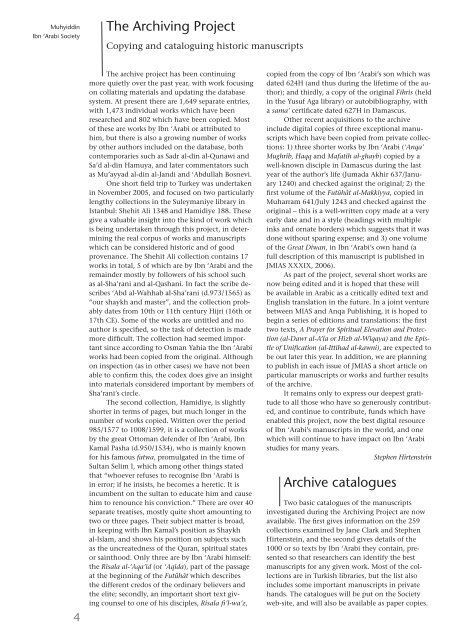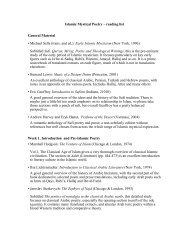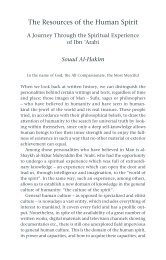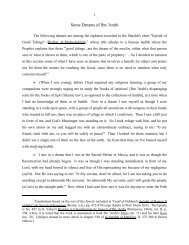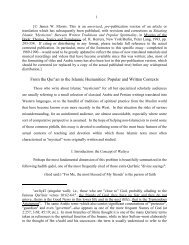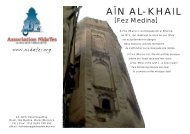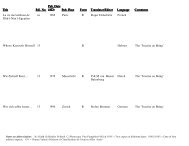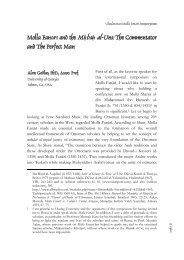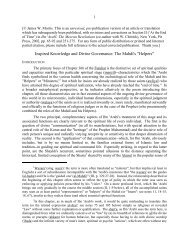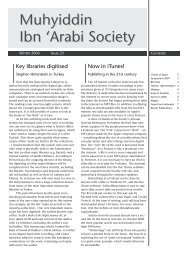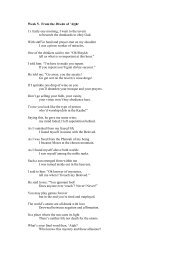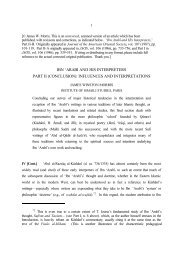Newsletter 22 - Muhyiddin Ibn Arabi Society
Newsletter 22 - Muhyiddin Ibn Arabi Society
Newsletter 22 - Muhyiddin Ibn Arabi Society
Create successful ePaper yourself
Turn your PDF publications into a flip-book with our unique Google optimized e-Paper software.
<strong>Muhyiddin</strong><strong>Ibn</strong> ‘<strong>Arabi</strong> <strong>Society</strong>The Archiving ProjectCopying and cataloguing historic manuscriptsThe archive project has been continuingmore quietly over the past year, with work focusingon collating materials and updating the databasesystem. At present there are 1,649 separate entries,with 1,473 individual works which have beenresearched and 802 which have been copied. Mostof these are works by <strong>Ibn</strong> ‘<strong>Arabi</strong> or attributed tohim, but there is also a growing number of worksby other authors included on the database, bothcontemporaries such as Sadr al-din al-Qunawi andSa’d al-din Hamuya, and later commentators suchas Mu’ayyad al-din al-Jandi and ‘Abdullah Bosnevi.One short field trip to Turkey was undertakenin November 2005, and focused on two particularlylengthy collections in the Suleymaniye library inIstanbul: Shehit Ali 1348 and Hamidiye 188. Thesegive a valuable insight into the kind of work whichis being undertaken through this project, in determiningthe real corpus of works and manuscriptswhich can be considered historic and of goodprovenance. The Shehit Ali collection contains 17works in total, 5 of which are by <strong>Ibn</strong> ‘<strong>Arabi</strong> and theremainder mostly by followers of his school suchas al-Sha’rani and al-Qashani. In fact the scribe describes‘Abd al-Wahhab al-Sha’rani (d.973/1565) as“our shaykh and master”, and the collection probablydates from 10th or 11th century Hijri (16th or17th CE). Some of the works are untitled and noauthor is specified, so the task of detection is mademore difficult. The collection had seemed importantsince according to Osman Yahia the <strong>Ibn</strong> ‘<strong>Arabi</strong>works had been copied from the original. Althoughon inspection (as in other cases) we have not beenable to confirm this, the codex does give an insightinto materials considered important by members ofSha’rani’s circle.The second collection, Hamidiye, is slightlyshorter in terms of pages, but much longer in thenumber of works copied. Written over the period985/1577 to 1008/1599, it is a collection of worksby the great Ottoman defender of <strong>Ibn</strong> ‘<strong>Arabi</strong>, <strong>Ibn</strong>Kamal Pasha (d.950/1534), who is mainly knownfor his famous fatwa, promulgated in the time ofSultan Selim I, which among other things statedthat “whoever refuses to recognise <strong>Ibn</strong> ‘<strong>Arabi</strong> isin error; if he insists, he becomes a heretic. It isincumbent on the sultan to educate him and causehim to renounce his conviction.” There are over 40separate treatises, mostly quite short amounting totwo or three pages. Their subject matter is broad,in keeping with <strong>Ibn</strong> Kamal’s position as Shaykhal-Islam, and shows his position on subjects suchas the uncreatedness of the Quran, spiritual statesor sainthood. Only three are by <strong>Ibn</strong> ‘<strong>Arabi</strong> himself:the Risala al-’Aqa’id (or ‘Aqida), part of the passageat the beginning of the Futûhât which describesthe different credos of the ordinary believers andthe elite; secondly, an important short text givingcounsel to one of his disciples, Risala fi’l-wa’z,copied from the copy of <strong>Ibn</strong> ‘<strong>Arabi</strong>’s son which wasdated 624H (and thus during the lifetime of the author);and thirdly, a copy of the original Fihris (heldin the Yusuf Aga library) or autobibliography, witha sama’ certificate dated 627H in Damascus.Other recent acquisitions to the archiveinclude digital copies of three exceptional manuscriptswhich have been copied from private collections:1) three shorter works by <strong>Ibn</strong> ‘<strong>Arabi</strong> (‘Anqa’Mughrib, Haqq and Mafatih al-ghayb) copied by awell-known disciple in Damascus during the lastyear of the author’s life (Jumada Akhir 637/January1240) and checked against the original; 2) thefirst volume of the Futûhât al-Makkiyya, copied inMuharram 641/July 1243 and checked against theoriginal – this is a well-written copy made at a veryearly date and in a style (headings with multipleinks and ornate borders) which suggests that it wasdone without sparing expense; and 3) one volumeof the Great Diwan, in <strong>Ibn</strong> ‘<strong>Arabi</strong>’s own hand (afull description of this manuscript is published inJMIAS XXXIX, 2006).As part of the project, several short works arenow being edited and it is hoped that these willbe available in <strong>Arabi</strong>c as a critically edited text andEnglish translation in the future. In a joint venturebetween MIAS and Anqa Publishing, it is hoped tobegin a series of editions and translations: the firsttwo texts, A Prayer for Spiritual Elevation and Protection(al-Dawr al-A’la or Hizb al-Wiqaya) and the Epistleof Unification (al-Ittihad al-kawni), are expected tobe out later this year. In addition, we are planningto publish in each issue of JMIAS a short article onparticular manuscripts or works and further resultsof the archive.It remains only to express our deepest gratitudeto all those who have so generously contributed,and continue to contribute, funds which haveenabled this project, now the best digital resourceof <strong>Ibn</strong> ‘<strong>Arabi</strong>’s manuscripts in the world, and onewhich will continue to have impact on <strong>Ibn</strong> ‘<strong>Arabi</strong>studies for many years.Stephen HirtensteinArchive cataloguesTwo basic catalogues of the manuscriptsinvestigated during the Archiving Project are nowavailable. The first gives information on the 259collections examined by Jane Clark and StephenHirtenstein, and the second gives details of the1000 or so texts by <strong>Ibn</strong> ‘<strong>Arabi</strong> they contain, presentedso that researchers can identify the bestmanuscripts for any given work. Most of the collectionsare in Turkish libraries, but the list alsoincludes some important manuscripts in privatehands. The catalogues will be put on the <strong>Society</strong>web-site, and will also be available as paper copies.


